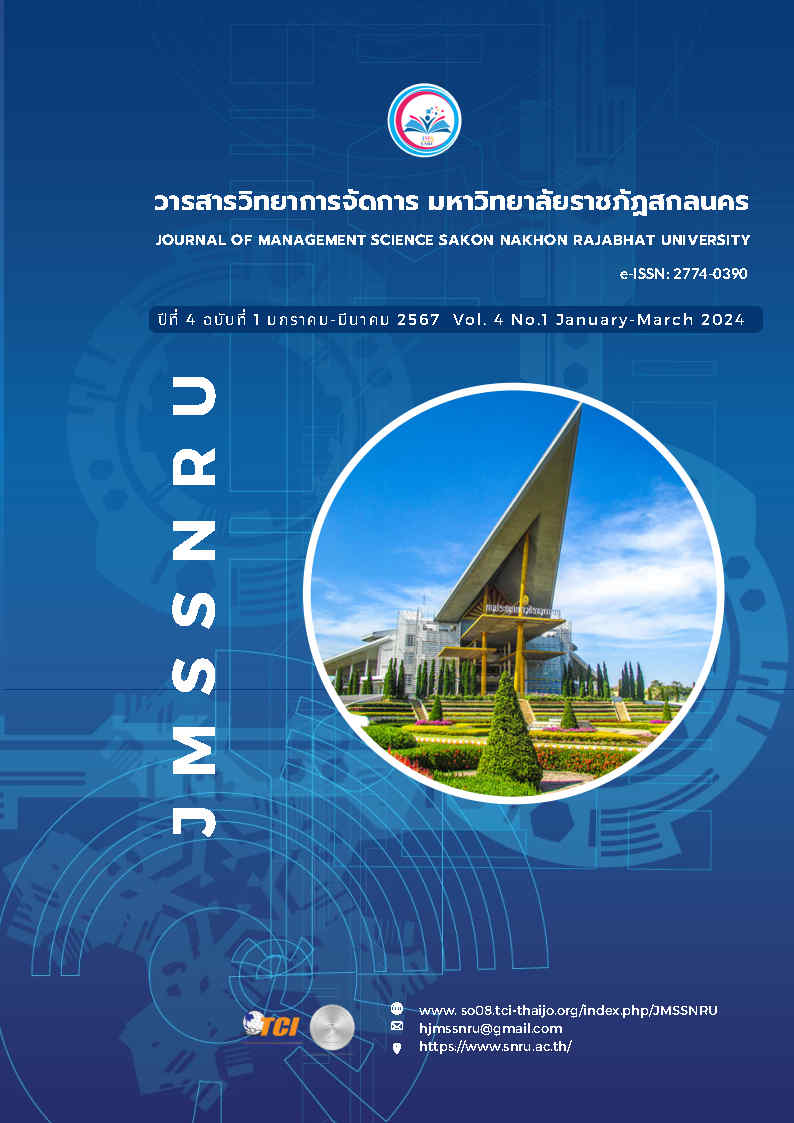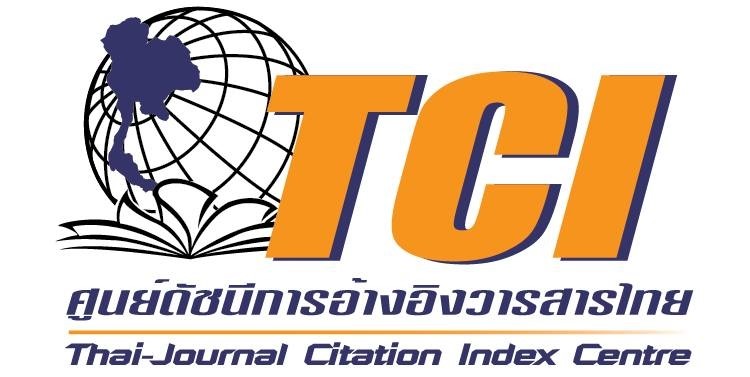การสร้างต้นแบบนโยบายการแก้ไขปัญหาความยากจนในพื้นที่นำร่อง ตำบลกุดบาก อำเภอกุดบาก จังหวัดสกลนคร
คำสำคัญ:
นโยบายสาธารณะ, ความยากจน, จังหวัดสกลนครบทคัดย่อ
การวิจัยนี้มีวัตถุประสงค์เพื่อพัฒนาต้นแบบนโยบายการแก้ไขปัญหาความยากจนที่ระบุถึงแนวทางการพัฒนามาตรการ และกลไกในการแก้ไขปัญหาความยากจนในพื้นที่ตำบลกุดบาก อำเภอกุดบาก จังหวัดสกลนคร โดยใช้วิธีการวิจัยเชิงปฏิบัติการแบบมีส่วนร่วม ผลการศึกษา พบว่า ต้นแบบนโยบายการแก้ไขปัญหาความยากจนในพื้นที่นำร่อง ตำบลกุดบาก อำเภอกุดบาก จังหวัดสกลนคร กำหนดเป้าหมายร่วมกัน ภายใต้วิสัยทัศน์ระยะสั้นและระยะกลาง “ชุมชนออนซอน มีอาชีพเสริมสร้างรายได้ เพื่อยกระดับคุณภาพชีวิต” วิสัยทัศน์ระยะยาว “กุดบากออนซอน” 3 ระยะ ระยะสั้น 3-6 เดือน ทดลองต้นแบบนโยบายยกระดับรายได้ ด้านการเลี้ยงสัตว์เพื่อสร้างความมั่นคงทางอาหาร “หอยเชอรี่ปลอดภัย” ด้านการเกษตร “เพาะกล้าออนซอน” ด้านแปรรูปผลิตภัณฑ์ผ้าคราม“ออนซอนผ้าคราม” เป้าหมาย “อยู่รอด” เพิ่มรายได้ ลดรายจ่าย มีอาหารบริโภคความอยู่รอด ระยะกลาง 1– 3 ปี โครงการความมั่นคงทางอาหารภายในครอบครัว โครงการชุมชนสะอาด โครงการยกระดับรายได้ โครงการชุมชนมีส่วนร่วม เป้าหมาย “อยู่ได้” มีอาหารในครัวเรือนที่เพียงพอ การจัดการขยะในครัวเรือนที่เหมาะสม ยกระดับรายได้ในครัวเรือน ระยาว 3 ปีขึ้นไป 5 มิติ แก้ไขปัญหาความยากจน มิติการพัฒนาคุณภาพตลอดชีวิต มิติการพัฒนาบ้านน่าอยู่ มิติการยกระดับรายได้ มิติชุมชนมีส่วนร่วม และมิติความมั่นคงด้านทรัพยากรเพื่อการมีคุณภาพชีวิตที่ดี
References
กมล สุดประเสริฐ. (2540). การวิจัยปฏิบัติการแบบการมีส่วนร่วมของผู้ปฏิบัติงาน. (พิมพ์ครั้งที่ 2). กรุงเทพฯ: สำนักงานประสานงานโครงการพัฒนาทรัพยากรมนุษย์.
จันทิมา ล่ามแขกและอจิรภาส์ เพียรขุนทด. (2564). การแก้ไขปัญหาความยากจนแบบบูรณาการ: กรณีศึกษา โครงการคู่เสี่ยว เกี่ยวก้อย แก้จน คนขอนแก่น. วารสารวิชาการธรรทรรศน์, 21 (2), 109-122.
ชนินทร์ วะสีนนท์และคณะ. (2565). รายงานผลการดำเนินโครงการสร้างต้นแบบนโยบายสาธารณะแบบมีส่วนร่วมของพหุภาคีเพื่อแก้ไขปัญหาความยากจนพื้นที่นำร่อง ตำบลุกดบาก อำเภอกุดบาก จังหวัดสกลนคร. สกลนคร: มหาวิทยาลัยราชภัฏสกลนคร.
ถวิลวดี บุรีกุล และคณะ. (2548). วัดระดับการบริหารจัดการที่ดี. กรุงเทพฯ: พิมพ์ดี.
ธาดา รัชกิจ. (2562). กระบวนการคิดเชิงออกแบบ (Design Thinking) เครื่องมือสำคัญของการสร้างความสำเร็จให้องค์กร. สืบค้น 8 มีนาคม 2566 จาก https://th.hrnote.asia/orgdevelopment/190702-design-thinking/.
พระครูปลัดเถรานุวัฒน์ (สุเทพ). (2564). การบริหารจัดการภาครัฐต่อปัญหาความยากจนและความเหลื่อมล้ำของสังคม. วารสารวิทยาลัยสงฆ์นครลำปาง, 10(1), 216-227
ภัทรา มาน้อย. (2548). ความยากจนในชุมชนบ้านแลง: สาเหตุและแนวทางแก้ไขที่เป็นไปได้. สืบค้น 8 มีนาคม 2566.
จาก http.//www.thaiall.com/research/jim_baan lang_poor.doc.
รัชนีวรรณ ศรีวิเศษ. (2543). ปัจจัยที่มีผลกระทบตอความยากจนในชุมชนชนบทของประเทศไทยศึกษากรณี: บ้านรางกร่างจังหวัดสุพรรณบุรี, วิทยานิพนธ์สังคมวิทยามหาบัณฑิต สาขาวิชาสังคมวิทยา จุฬาลงกรณ์มหาวิทยาลัย.
วิบูลย์ รัตนาภรณ์วงศ์. (2563). การพัฒนารูปแบบแก้ปัญหาความยากจนของชุมชนในประเทศไทย. วารสารสังคมศาสตร์และมานุษยวิทยาเชิงพุทธ, 5(4), 261-280.
ศุภชัย ยาวะประภาษ. (2550). นโยบายสาธารณะ. กรุงเทพฯ: สำนักพิมพ์แห่งจุฬาลงกรณ์มหาวิทยาลัย.
สามารถ จันทร์สูรย์และคณะ. (2564). กลยุทธ์การจัดการศึกษาเพื่อแก้ปัญหาความเหลื่อมล้ำและความยากจน. วารสาร มจร การพัฒนาสังคม, 6(1), 111 – 126.
สุจิตรา คุ้มฉาย. (2564). นโยบายสาธารณะ: ชิม ช้อป ใช้ ในประเทศไทย. Journal of Modern Learning Development, 6(1), 380-394.
สำนักงานสภาพัฒนาการเศรษฐกิจและสังคมแห่งชาติ. (2564). ตัวชี้วัดการพัฒนาระดับจังหวัดและกลุ่มจังหวัด. สืบค้น 12 ตุลาคม 2566.
อาทิตย์ บริหาร และยุภาพร ยุภาศ. (2565). การวางแผนนโยบายสาธารณะโดยใช้กระบวนทัศน์แบบองค์รวมและการมีส่วนร่วมของประชาชน. วารสารการบริหารนิติบุคคลและนวัตกรรมท้องถิ่น, 8(3), 397 – 405.
Cohen & Uphoff. (1980). Effective Behavior in Organizations. New York: Richard D. Irwin Inc.
DEX Space. (2559). DESIGN THINKING คืออะไร (OVERVIEW). สืบค้น 8 มีนาคม 2566 จาก
https://medium.com/base-the-business-playhouse/design-thinking-คืออะไร-overview-dc8c8e7547db/.
Downloads
เผยแพร่แล้ว
How to Cite
ฉบับ
บท
License
Copyright (c) 2024 วารสารวิทยาการจัดการ มหาวิทยาลัยราชภัฏสกลนคร

This work is licensed under a Creative Commons Attribution-NonCommercial-ShareAlike 4.0 International License.
บทความที่ตีพิมพ์ในวารสารวิทยาการจัดการ มหาวิทยาลัยราชภัฏสกลนคร เป็นทัศนะ ลิขสิทธิ์ และความรับผิดชอบของผู้เขียนเจ้าของผลงาน






